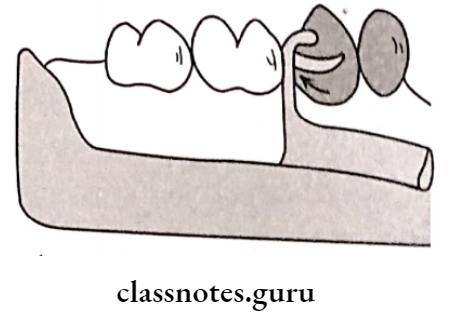Question 1. Internal attachments.
Answer:
Definition of Internal attachments:
“A retainer, used in removable partial denture construction, consisting of a metal receptacle and a closely fitting part:
- The former is usually contained with the normal or expanded contours of
- The crown of the abutment tooth and the latter is attached to a pontic or the denture framework”.
Types of Internal attachments:
- Ney-Chayes attachment
- Stern Goldsmith attachment
- Baker attachment
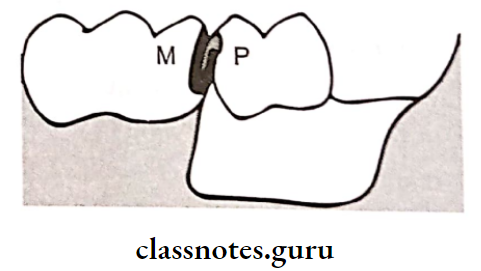
Advantages of Internal attachments:
- It eliminates the visible retentive component
- It eliminates the visible vertical support
- It provides horizontal stabilization
- It stimulates the underlying tissues
Disadvantages of Internal attachments:
- It requires the preparation of abutments
- It requires tedious lab procedures
- It leads to tooth wear
- It is least effective in teeth with small crowns It is difficult to place
Read And Learn More: Prosthodontics Question And Answers
Contraindications of Internal attachments::
- Teeth with large pulp
- Cost efficient
Question 2. Canine rests.
Answer:
It is a form of indirect retainer
- Indication: If the mesial marginal ridge of the first premolar is close to the fulcrum line
- Modification: The minor connector can be placed anterior to the canine
- Advantage: It increases the efficacy of the indirect retainer
Question 3. Purposes of a surveyor.
Answer:
- To survey the diagnostic and primary casts
- For tripoding the cast
- To transfer the tripod marks to another cast
- To contour crowns and cast restorations
- To perform mouth preparation directly on the cast to determine the outcome of treatment
- To survey the master cast
- To survey ceramic veneers before final glazing
Question 4. Gingivally approaching clasps
Answer:
It is infrabulge clasp
Gingivally approaching clasps Advantages:
- Easy to seat
- Esthetic
- Does not increases the occlusal load
- No decalcification of teeth
Gingivally approaching clasps Disadvantages:
- It tends to collect food debris
- It needs additional stabilizing units
Question 5. Survey Lines
Survey Line: “A line drawn on a tooth or teeth of a cast by means of a surveyor for the purpose of determining the positions of the various parts of a clasp or clasps”.
- High Survey Line:
- This line passes from the occlusal third in the near zone and to the occlusal third in the far zone
- If the survey line lies higher in position, the undercut will be deep
In this wrought wire clasp with more flexibility is used It is usually common in inclined teeth and in teeth with greater occlusal diameter than its cementoenamel junction
- Medium Survey Line:
- It passes from the occlusal third in the near zone to the middle third in the far zone
- In it Aker’s clasp is used
- Low Survey Line:
- This survey line is closer to the cervical third of the tooth in both near and far zone
- A modified T clasp is used for teeth with low survey line
CLASP used: A modified T – Clasp is used

Question 6. U-shaped major connector.
Answer:
- It has a thin metal band running along lingual surface of posterior teeth
- Anteriorly it covers cingula of the teeth
U-shaped major connector Indications:
- Used in Kennedy’s class IV
- Used in presence of tori
- Used in excessive over bite
U-shaped major connector Advantages:
- Reasonably strong
- Has moderate indirect retention and support
U-shaped major connector Disadvantages:
- When vertical forces are applied on either one or both ends it tends to straighten
- Greater bulk is required to avoid flexing of the major , connector
- Increased thickness may cause patient discomfort
Question 7. Indications for removable partial dentures (RPD).
Answer:
- Length of Edentulous span – RPD are preferred for longer edentulous arches as it helps to distribute forces around the ridge evenly
- Age – RPD are preferred in young patients due to presence of large dental pulps
- Abutment – When there is no tooth posterior to the edentulous space to act as abutment, RPD is preferred
- Periodontal support – Tooth with weakened periodontal support are preferred for RPD as it requires less support from the abutment

- Cross- Arch stabilization – To stabilize the remaining teeth against lateral and anteroposterior forces, RPD is indicated
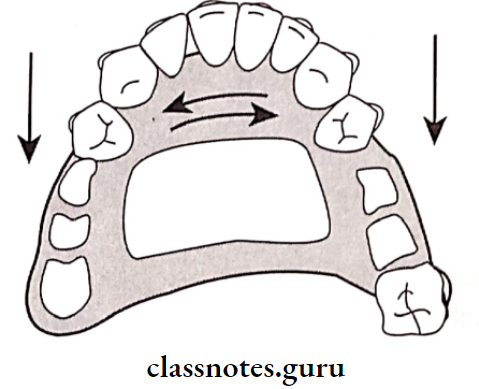
- Excessive Bone Loss – In case of ridge resorption, RPD can be fabricated as it can provide the required support and esthetics
- Immediate Teeth Replacement – RPD is preferred as relining can be done
- Esthetic requirement – If required
- Emotional problems – RPD is indicated as it requires shorter appointments
- Patient desires –
- If the patient wants RPD due to
- Avoidance of operative procedure
- Economic reasons
- Severe loss of tissue
- Teeth with short clinical crown
- When more than two posterior teeth or four anterior teeth are missing
- If the canine and two of its adjacent teeth are missing
- When there is no distal abutment
- Presence of multiple edentulous spaces
- In case of tilted abutment
Question 8. Factors determining path of insertion.
Answer:
- Aesthetics: The cast should be tilted so that the height of contour is shifted to a lower level This conceal the clasp arm as well as alters the path of insertion
- Guiding Planes: Two or more vertically parallel surfaces of abutment teeth so oriented as to direct the path of placement and removal of removable partial denture”
- The path of insertion will always be parallel to the guide plane
- The proximal plates on the partial denture will contact the guide planes during insertion
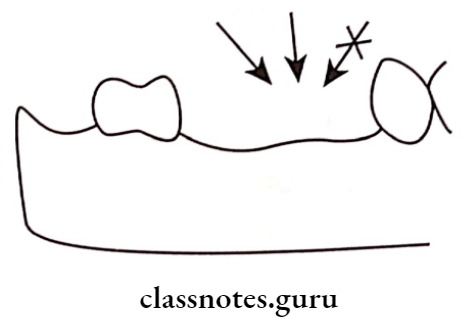
-
- Location of the vertical minor connector
- This minor connector will be parallel to the guide plane on the abutment which in turn determines the path of insertion

- Interference:
- Certain areas can cause interference to insertion
- If these cannot be surgically removed, the path of insertion should be altered
- Examples:
- In Mandible:
- Lingual tori
- Lingually placed teeth
- Bony exostoses
- In Maxilla:
- Tori palatinus
- Buccaly tipped teeth
- Bony exostoses
- In Mandible:
- Retentive undercuts:
- Favourable undercuts should be evaluated to ob- tain good retention
- The cast can be tilted until the height of contour lies between the gingival and middle third of the crown to obtain a good undercut
- This tilting of the cast will alter the path of insertion
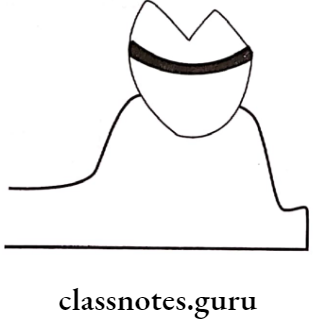
- Point of origin of the approach arm of a bar clasp:
- The Approach arm forms a loop that produces terference during insertion
- if the approach arm cannot be modified the path of insertion is to be altered
- When the path of insertuion is altered the resulting bar clasp will not provide retention rather it will provide resistance to removal
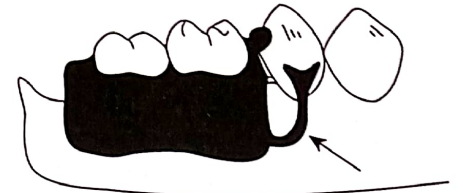
- Denture base:
- Shape and extent of it determines the path of insertion
- If the denture base extends anteriorly on both sides, it embraces abutment limiting multiple paths of insertion

Question 9. Single Palatal Bar.
Answer:
It is a bar running oval cross-section.
- Design:
- It has a narrow half across the palate
- It is thickest at the centre
- Fabrication:
- Mark the extent of the bar on a cast
- The wax pattern is fabricated and adapted over the area
- Indication:
- For interim partial denture
- Disadvantages:
- Poor bony support
- Cannot be used anterior to the premolar
- It has poor vertical support
- It can be used only in Kennedy’s Class 3 cases
Question 10. Factors determining clasp retention/flexibility.
Answer:
- Depth of the undercut: The deeper the undercut the greater is the retention
- Buccolingual width of the undercut:
- Clasp alloys are selected based on it
- For 0.010″ undercut – Cast chrome alloy
- For 0.015″ undercut – Gold alloy
- For 0.020″ undercut – Wrought wire
- The distance between the survey line and the tip of the retentive clasp:

- The mesiodistal length of the clasp arm below the height of contour:
- Longer clasp arms offer more flexibility
- Increased flexibility decreases the magnitude of the horizontal stresses acting on the abutment
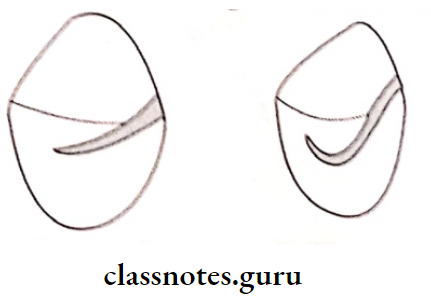
- Taper of the clasp arm:
- The clasp arm should taper uniformly from its origin to the tip
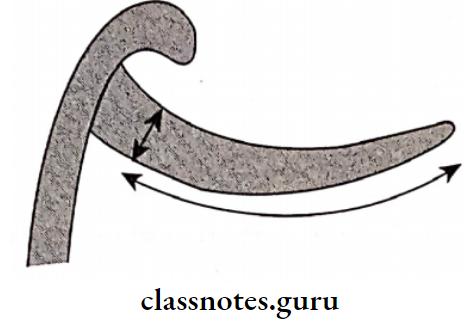
- Cross-sectional form:
- A half round clasp arm is flexible only in one plane
- While round clasp is flexible in all planes
- A cast retentive clasp arm is used mainly in tooth-supported partial dentures because they need to flex only during placement and removal of the denture
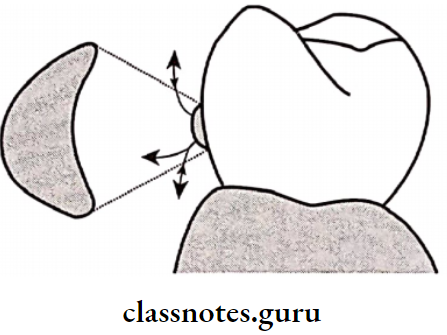
Question 11. Occlusal Rest Seat Preparation.
Answer:
The location and extent of the rest seat is determined during the surveying of a diagnostic cast

1. On Enamel:
- A depth orientation groove is drawn along the desired outline
- Next the enamel is removed between these grooves using the same bur
- The design is then verified with that marked on the primary cast
- Occlusal clearance is checked with the help of beading/utility
- Rounding of internal line angles is carried out
- Any unsupported enamel if remaining are removed
- Finally, polishing of the rest seat is carried out
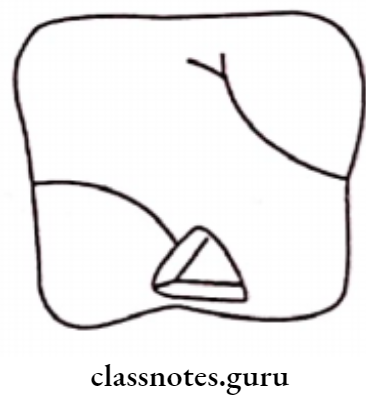
2. Gold Restoration:
- Tooth reduction/preparation is carried out for gold restoration
- Depression is made on the tooth surface at the place of rest seat
- Initially, the rest seat is prepared on a wax pattern using No. 4 round bur in slow speed hand piece or with discoid or cleoid excavator
- It is polished using a finishing bur
- Finally the wax pattern is cast
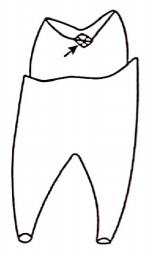
- On Amalgam Restoration:
- Rest seat preparation over amalgam restoration is usually avoided as it would weaken the restoration
- For Embrasure Clasp:
- Two occlusal reset seats are to be prepared over the involved teeth
- Both the marginal ridges are reduced equally, but the contact point should not be removed
- The outline must be verified
- Finally, finishing and polishing is done using No. 4 round steel bur

Question 12. Methods for obtaining functional support for distal extension base.
Answer:
Support for distal extension base is obtained by following methods
- Functional Impression Technique:
- The tissues get compressed during function leading to the vertical displacement of the denture
- This type of tissue ward movement of the denture will produce rotation of the prosthesis around its terminal abutment axis
- This is prevented if the tissues are recorded in a compressed form
- The denture fabricated from it will seat and compress the tissues even during rest and there will be no additional tissue ward movement during function
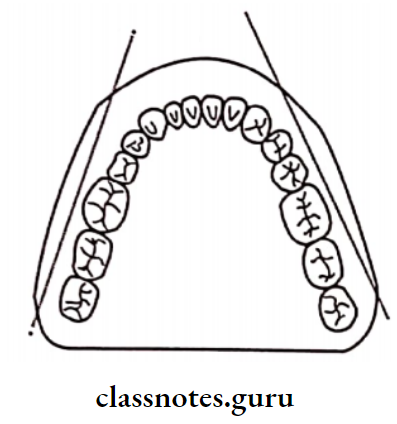
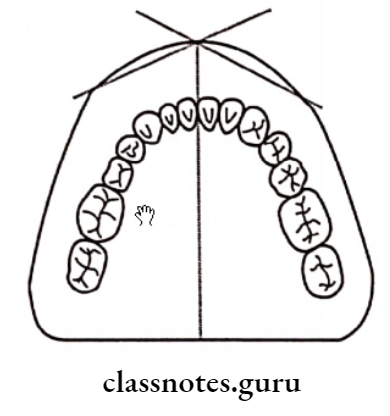
- Providing minimal occlusal contact
- The occlusal load can affect the support of the denture
- The occlusal table of the artificial teeth should be narrowed to reduce the occlusal load
- Identification of stress-bearing area
- The distal extension base derive support from the stress bearing area
- These areas are identified in maxillary and mandibular arch
- Maxillary:
- Buccal slopes of the ridge
- Hard palate Crest of the ridge
- Mandibular:
- Buccal shelf area
- Slopes of the ridge
- Minimizing the movement of the denture base:
- The denture base should be designed such that the forces acting on the edentulous ridge can be minimized
- Minor connectors are added to avoid the rotation of the denture
- Increasing the tissue coverage of the denture base:
- Increasing the tissue coverage leads to wider distribution of the occlusal load
- Thus, it provides support
Question 13. Distal extension denture base.
Answer:
Distal extension denture base are fabricated in case of Kennedy’s class 1 and class 2 cases
- Support for such bases is necessary as the occlusal load may rotate the denture
- Support for a distal extension denture is obtained from both the teeth and the tissues
- Among it the teeth are less compressible and intrude little to the occlusal load compared to the supporting soft tissues.
Factors Effecting It:
- Quality of soft tissues
- Quality of underlying bone Tissue coverage of denture base
- Amount of forces acting on denture Stress bearing area
- Fit of the denture
- Type of Impression
Question 14. Methods of establishing occlusal relationship in removable partial denture.
(or)
Occlusal relation in removable partial denture.
Answer:
- Noncontact relation:
- Protursion
- Lateral movement
- Rest position and freeway space
- Contact relation:
- Protursive
- Retrusion
- Lateral
- Canine guided
- Group function
- Intercuspal
Methods:
- Direct apposition of cast:
- Cast are fabricated
- These cast are articulated
- Occlusal is established over the cast on the articulator itself
- Interocclusal record on remaining posterior:
- The upper and lower trial dentures are inserted into patients mouth
- Wax or impression paste is loaded onto the occlusal surface of teeth in the mandibular occlusal rim
- The patient is asked to slowly retrude the mandible and close on the wax till tooth contact occurs
- The trial dentures are removed and the wax is allowed to cool
- Both the maxillary and mandibular trial dentures are placed on their articulated casts.
- Occlusal relation with record base and rims:
- Rims made from wax or modeling plastic are fabricated over record base
- These are inserted into patient’s mouth and various mandibular movements are recorded
- Entirely with rims:
- The occlusal relation is recorded with the help of extraoral tracing
- The record bases attached to the recording devices are inserted in the patient’s mouth
- The pointer is coated with precipitated chalk and denatured alcohol
- The patient is asked to perform protrusive, lateral, and anteroposterior movements

- Registration of occlusal pathways:
- Record base is fabricated using metal/resin
- A layer of sticky wax is placed over it
- Next, occlusal rim by hard inlay wax is fabricated It is inserted into patient’s mouth
- Mandibular movements are recorded
Question 15. Direct v/s Indirect Retention.
Answer:
Direct Retention:
- Retention obtained in a removable partial denture by the use of clasps or attachments that resist removal from the abutment teeth.
- Component of a removable partial denture used to re- tain and prevent dislodgement consisting of a clasp assembly called direct retainer
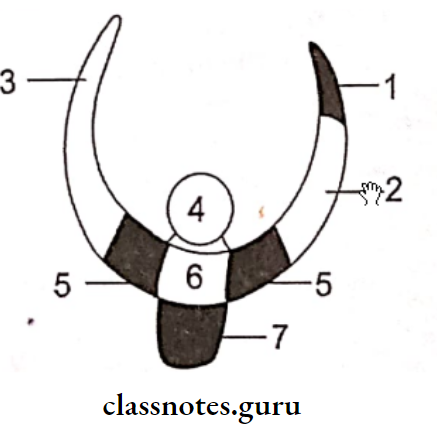
- Retentive terminal
- Retentive clasp arm
- Reciprocal arm
- Occlusal rest
- shoulder
- Body
- Minor Connector
- It is the ability of the component to prevent the distion and provide indirect retention placement of the denture
Indirect Retention:
- It is the effect achieved by one or more indirect retainers of removable partial denture that reduce the tendency for a denture base to move in an occlusal direction or rotate about the fulcrum line.
- The component of a removable partial denture that assists the direct retainer in preventing displacement of the distal extension denture base by functioning through lever action on the opposite side of the ful- crum line called indirect retainer

- It is the ability of the component to retain denture in place
Question 16. Immediate partial denture.
Answer:
“A complete removable partial denture constructed for insertion immediately following the removal of natural teeth”
Types of Immediate partial denture:
- Temporary Immediate Partial denture
- Indicated when the permanent immediate partial denture is likely to become ill-fitting due to more than normal bone resorption
- Permanent Immediate Partial denture
- Indicated when bone resorption is expected to be less and denture prognosis is good
Advantages of Immediate partial denture:
- It is more esthetics
- Prevents supra-eruption and drifting of the opposing and adjacent teeth
- It acts like a splint over the surgical site thus controls hemorrhage and swelling
Question 17. Swing Lock.
Answer:
- Described by Dr. Joe J.Simmons
- It has a labial bar in addition to lingual major connector
- The labial bar extends labially all along the arch
- It is attached to the remaining parts of the denture by a hinge on one side and a lock on the other
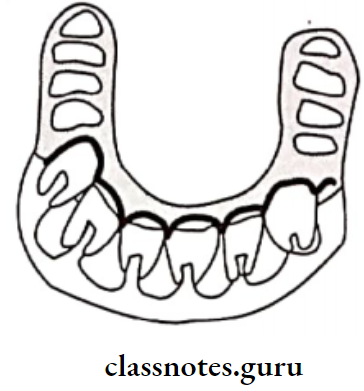
Swing Lock Method Of Use:
- It is unlocked during insertion and locked after insertion
- As the labial bar moves around a hinge joint these dentures are called “Swing lock dentures”
Swing Lock Function:
- To support periodontally weak teeth
Swing Lock Indications:
- If the functional abutment teeth are missing
- In case of abutment teeth that has questionable prognosis
- Presence of few remaining teeth
- Presence of unfavorable tooth contours
- When the position of the remaining teeth does not facilitates conventional design
- Presence of unfavorable soft tissue contours
- For retention and stability of a maxillofacial prosthesis.
Swing Lock Contraindications:
- Poor oral hygiene
- Shallow vestibule
- High frenal attachment
Swing Lock Advantages:
- Inexpensive
- Provide stability and retention
- It is possible to add additional teeth to it
Swing Lock Disadvantages:
- Poor esthetics
- Leads to lingual tipping of the teeth
Swing Lock Fabrication:
Metal selection chrome alloy
↓
Surveying of cast
↓
Designing of various components
↓
Making the impression
↓
Fabrication of framework
↓
Trying of the framework
↓
Jaw relation and teeth arrangement
↓
Insertion of the prosthesis
